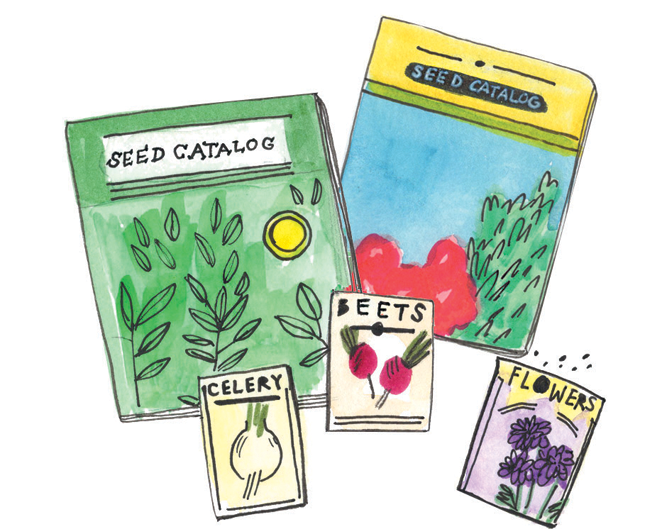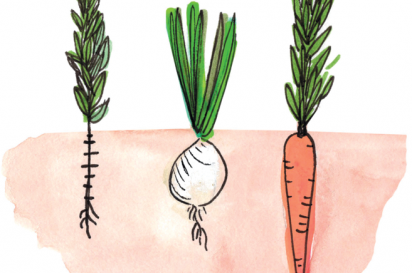Seeding Winter Dreams
For me, winter is a time to figure out what I will plant in my food gardens and in containers come springtime. What you plant should be based on how much space, time and money you have. Yet it is so easy to be seduced by enticing displays in garden centers and gorgeous layouts in magazines and catalogs.
The theory: If you have a plan, your impulsive purchases will be fewer and your satisfaction will be greater.
Here are some core ideas to get you started.
Seeds vs. Plants: How could something so small seem so intimidating? Starting plants from seeds is truly not complex. They need light, water and a watchful eye. But knowing when to start seeds, keeping track of planting depth and whether to start the seeds indoors or out can be bewildering. Consider creating a chart or spreadsheet to keep track of what you have purchased and the planting details described on each seed packet. One of my best resources is the catalogs I receive in fall and early winter. The companies below have online stores and a catalog that can be sent out at your request. Once you get on a few mailing lists, many catalogs from other vendors will flow into your mailbox. One exception is Seed Saver’s Exchange, which is a nonprofit organization. As a member, you will receive the catalog and newsletter.
Whether to buy and start seeds or purchase plants is an age-old question. With seeds you have a bigger selection, especially of heirloom varieties, and buying seeds is less expensive than buying plants. Many seeds will remain viable for up to 10 years, although the percentage of the seeds that will germinate decreases over time. Consider buying organic seeds—you and your family will be eating the food these plants produce.
What if you do not have the time or space to start seeds or the seed-starting window has passed? Buy plants instead. This option costs more, but think of the instant gratification of having a garden already filled with plants. You can find a good selection of well-grown plants at farmers markets, spring plant sales or garden centers. Take the opportunity to talk to the growers of the plants you purchase. They are experts and can teach you a lot.
Space: When we picture a garden it is usually a beautifully planted in-ground plot. This works if you have the space and if your soil is good, or you are prepared to amend it. But if your soil is heavily compacted or low in nutrition and you want to create garden areas with good topsoil and compost, consider a raised bed system. There are many types of raised bed structures on the market. Or build your own—it’s not difficult and is usually less expensive.
As a culture, we are moving toward smaller homes, condominiums and apartments. Containers are the answer for smaller spaces both inside and outside. These movable gardens can easily hold an herb collection, small fruit trees and shrubs or sublime displays of annuals and tender perennials. There are endless container choices that range in materials from classic terracotta to metal to weather-resistant plastics.
Another container option is to create successional vegetable gardens. Plant your container with seeds and small herb plants in the early spring (see sidebar). As the season progresses and the spring plants begin to be affected by the summer heat, start your summer planting. In mid-August, transition to late-season crops. In the past, by mid-summer, seeds and food plants were just not available. But this has changed. Garden centers are now embracing and promoting year-round gardening, and there are festivals throughout the summer that celebrate different food plants where you can buy plants and seeds.
One last note about successional gardening: You can extend your season by placing row covers over your containers once the fall frosts strike. Imagine eating lettuce in December and January.
Pests: Sometimes our efforts are derailed by animals who find our gardens tasty. There are many books on how to protect gardens from hungry critters. One of my favorites is Backyard Battle Plan by Cooper Rutledge. Another good resource is the local cooperative extension office. And don’t forget your fellow gardeners, who are happy to share their war stories. Gardening may sometimes be a solitary activity, but the gardening community is vast in number, knowledge and good will. Just ask a question.
Seed Companies (some are carried by local garden center)
Baker Creek Heirloom Seeds www.rareseeds.com
Botanical Interests www.botanicalinterests.com
Fedco Seeds www.fedcoseeds.com
Hudson Valley Seed Company www.hudsonvalleyseed.com
Irish Eyes Garden Seeds www.irisheyesgardenseeds.com
Renee’s Garden www.reneesgarden.com
Seed Savers Exchange www.seedsavers.org
Territorial Seed Company www.territorialseed.com
Vegetable & Herb Succession Gardens:
Seeded in late March to early April: dwarf peas, lettuce, tatsoi, mesculum mixes, spinach, beets, dill, parsley, coriander/cilantro
Planted in mid-May to early June: New Zealand spinach, scarlet runner beans, patio tomatoes, cucumbers, basil, oregano, summer squash, zucchini, miniature winter squash
Planted/seeded in mid-August: peas, lettuces, tatsoi, mesculun mixes, kale, collards, beets, dill, radishes
Who to Consult:
Master Gardeners and county cooperative extension offices
BYGL (Buckeye Yard & Garden onLine), bygl.osu.edu
Farmers Markets and CSA (Community Supported Agriculture) farmers
Your local garden centers






